Every year, businesses process 4.2 billion expense receipts, yet most companies are leaving serious money on the table through inefficient expense tracking and lost billable hours (about $3,800 per employee annually, to be exact).
The receipt scanning technology that powers cashback apps has quietly revolutionized how businesses track expenses, manage receipts, and—most importantly—capture billable time. This same technology is transforming workforce management, creating value for employees, managers, and businesses through better time and expense tracking.
Here’s the thing: most business owners don’t realize: the technology behind receipt scanning isn’t just about cashback. It’s the same innovation that’s revolutionizing how teams track time, log expenses, and prove their productivity.
How Receipt Scanning Actually Works
The tech behind receipt scanning is genuinely impressive. Modern OCR (optical character recognition) hits about 98.7% accuracy, even with those faded, crumpled receipts you dig out of your pocket three days later.
These systems don’t just read text; they’re smart enough to recognize over 50,000 different receipt formats. Got a blurry photo from Target? No problem. A water-damaged receipt from your local grocery store? They’ll figure it out. The neural networks powering these apps have seen millions of receipts, so they know exactly what to look for. Users can discover top cash back apps that process uploads in under three seconds, which is faster than it takes to stuff the receipt in your wallet.
Behind the scenes, it’s all cloud computing magic. AWS Lambda functions fire up the instant you submit a photo, while containerized microservices check your data against massive product databases. Whether it’s processing 10 receipts or 10 million, the system scales automatically without breaking a sweat.
The Real Cost of Poor Time and Expense Tracking
Talking numbers that make a difference to your bottom line. The same research by the industry shows that manual time tracking and expense reporting cost businesses an average of 2.5 hours every employee per week. It amounts to 130 hours per employee per year, which is 3+ weeks of productivity lost.
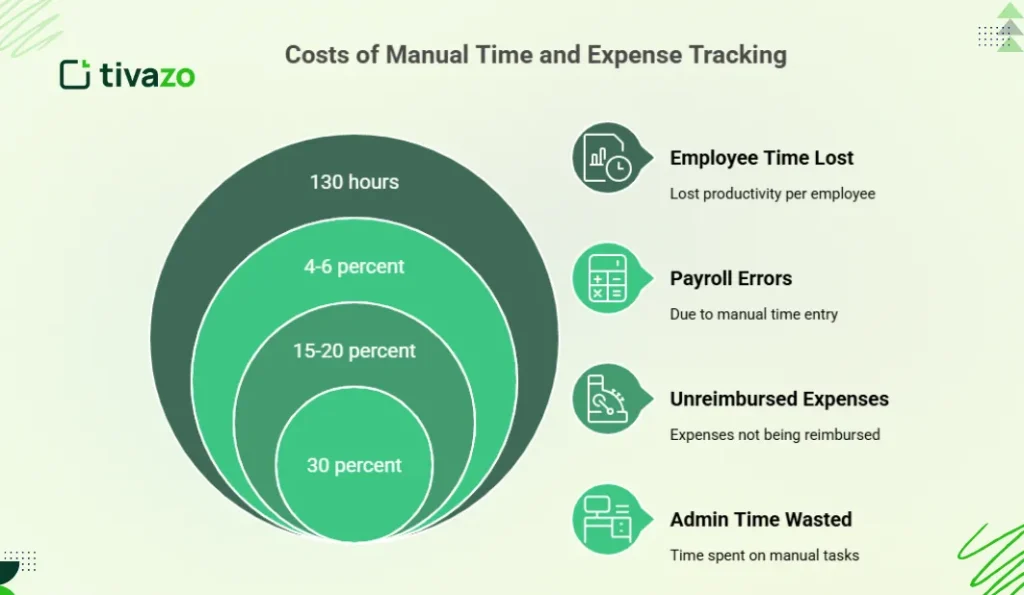
The hidden costs add up fast:
- Time entry mistakes made by people are costing 4-6 percent of the total payroll.
- Lack of good expense tracking results in 15-20 percent of expenses that are not being reimbursed.
- The administrative teams dedicate 30 percent of their time to receiving, processing, and checking receipts.
- Late reporting of expenses has its cash flow and tax compliance problems.
The best thing about the latest technology of receipt scanning is that it removes these pain points. Employees are not lost in paperwork at the end of the month, but the second they obtain a receipt, they take a photo. The system automatically:
- Gets out all the necessary information (date, merchant, amount, category).
- The expenses are matched to the project or time entry.
- Violation of the Flags policy prior to submission.
- Prepares accounting and client bill reports.
In the case of remote teams and businesses that are service-oriented, this time tracking and expense management integration is a game-changer.
Why Employees Actually Use Modern Time Tracking
There’s serious psychology at play in getting teams to consistently track time and expenses. Traditional time sheets fail because they’re tedious, easy to forget, and feel like busywork.
Modern platforms understand what motivates employees. They use the same psychological principles that make receipt scanning apps addictive—but apply them to productivity:
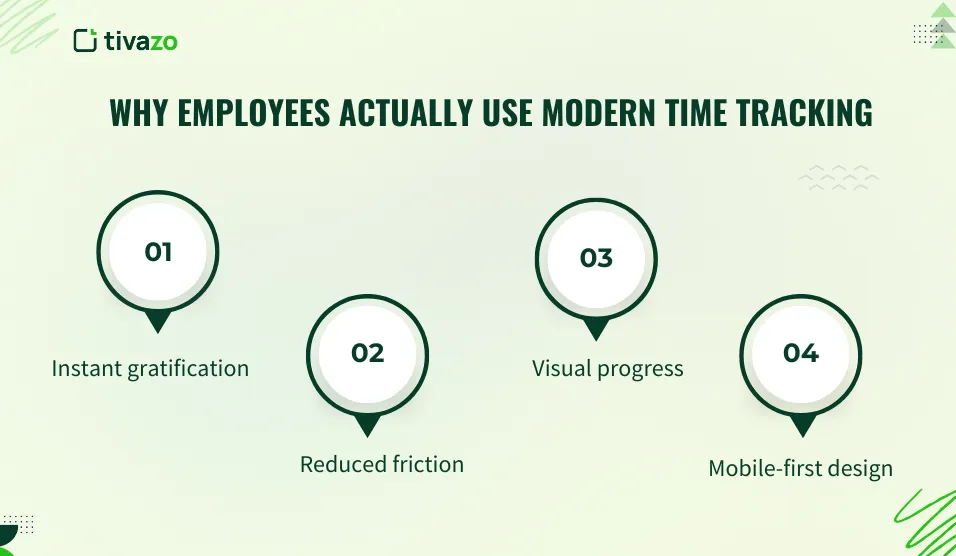
- Instant gratification: See your logged hours and billable amount update in real-time
- Reduced friction: One-tap time tracking beats filling out timesheets
- Visual progress: Daily/weekly productivity dashboards satisfy our need for achievement
- Mobile-first design: Track time and expenses from anywhere, anytime
The Economist found that user-friendly time tracking systems increase compliance by 143%. When employees can photograph a receipt and have it automatically categorized to their current task, they actually do it.
And don’t get me started on the social features. Team dashboards showing project progress create healthy accountability. Managers can spot bottlenecks before they become crises. Everyone knows where the team stands without micromanagement.
What Businesses Learn From Time and Expense Data
This is where the actual worth is of the companies operating with incorporated time tracking and receipt management systems is. The insights are remarkable:
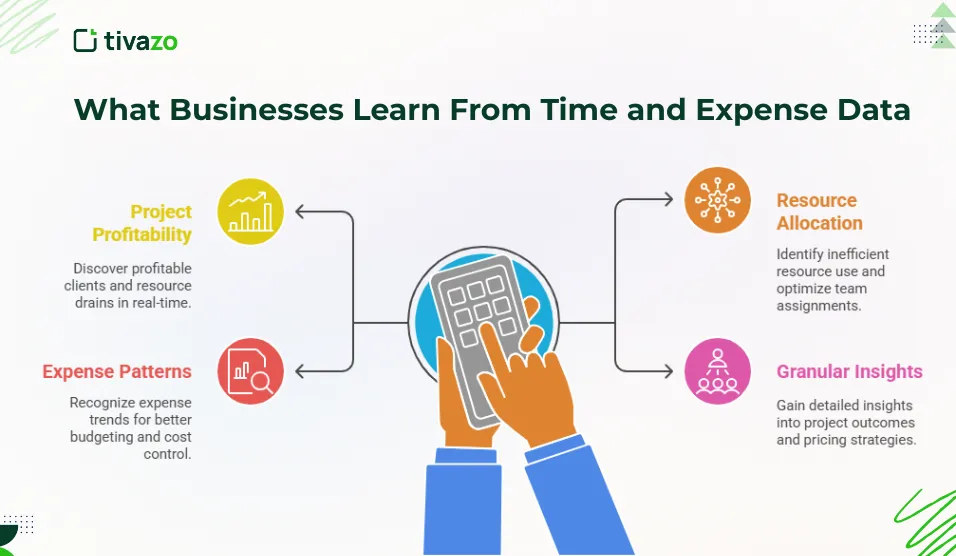
- Real-time project profitability: Find out which clients, projects, or services is actually profitable and what is a resource drain. The old way of accounting may tell you this, quarterly new systems tell you every day.
- Resource allocation intelligence: Learn that your senior developer wastes 34% of billable hours in meetings. Notice that some types of projects always exceed the budget. Determine the most effective team members to do particular work.
- Expense pattern recognition: It is noticed that remote workers in some cities can claim expenses 40 percent higher. Know that there are certain tools or traveling necessary for the particular types of projects. Know the patterns of seasonal expenses in order to budget better.
- The granularity is insane. A consulting firm is able to follow up on whether or not the client site visits have positive outcomes on projects. The creative agency will know which projects need to be revised most and will set pricing.
Conventional financial analysis is backward-looking in regard to past projects. Receipt and time tracking data provide information on what is really happening, allowing you to correct the course before the issues get compounded.
Technical Integration: Making Everything Work Together
The reception processing does not always go well, particularly when it comes to integrating with the other business systems. Thermal paper fades fast. Notes are written in receipts by the employees. Currency conversion is required on international receipts. Individuals actually do not keep track of time.
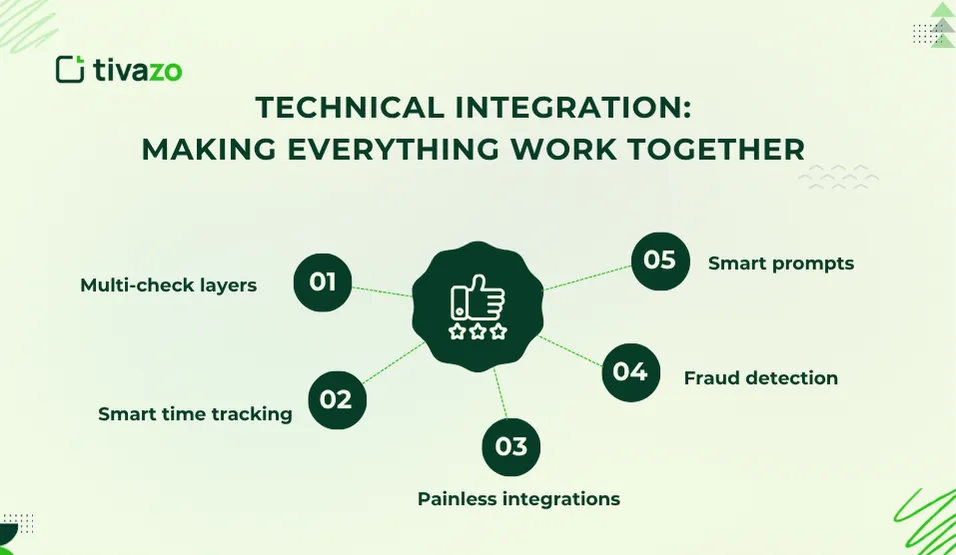
The resolutions that contemporary platforms resort to are ingenious:
- Multi-check layers: The OCR engines also take each receipt, and the AI algorithms put it against the company expense policies and notice anomalies.
- Smart time tracking: GPS verification of remote employees, automatic break detection, and idle time tracking that does not endanger privacy but is also accurate.
- Painless integrations: Integrate with QuickBooks, Xero, SAO, and other business applications so that information can run automatically without having to enter it twice.
- Fraud detection: The systems identify multiple receipt submissions, suspicious patterns, and audit trails to ensure compliance. These models detect the fake submissions 94 percent of the time.
- Smart prompts: In case the employee has not registered time at the end of the day, he or she receives a friendly reminder. Miss a receipt upload? The system notifies you prior to the paper going out of memory.
Limiting the rates is what makes it reasonable as well. The systems monitor velocity, patterns, and anomalies to ensure data integrity and happy legitimate users.
Privacy and Data Security in Workforce Tracking
This is where the interesting (and somewhat disturbing) aspect comes in. Everything can be seen in time tracking and the receipt data: work patterns, information on clients, habits of spending and productivity rates.
Smart platforms are aware that it is delicate material and therefore they have sophisticated privacy and security controls:
For employees:
- Sees right through what is being tracked and why.
- Personal vs. business time boundary controls.
- Monitoring that is more concerned with work output rather than surveillance.
- Data processing and deletion rights in GDPR and CCPA.
For businesses:
- Financial information that is sensitive is encrypted end-to-end.
- Role-based access controls (finance views expenses, managers view time, executives view summary)
- Compliance and Dispute resolution audit trails.
- International team residency.
According to MIT Technology Review, 78 percent of workers now seek clear tracking policies, and platforms are reacting to the call. The most optimal systems accommodate reasonable business interests and the privacy of employees.
Real-World Applications: Who Benefits Most
Service-based businesses: enduring businesses such as law firms, consulting firms, IT services and creative studios are billable hour businesses. Combined time and cost monitoring implies that all minutes and all dollars are recorded and billed properly.
- Remote and hybrid teams: As soon as staff members conduct their business at home, coffee shops, or with clients, automated receipt scanning and mobile timekeeping will be used to make sure that nothing falls through the cracks.
- Project-based organizations: Construction, marketing campaigns, software development- any work done in discrete projects requires granular-scale time and expense tracking to know real profitability.
- Field service businesses: Technicians, sales representatives, and delivery squads in the field can take snapshot photos of receipts and record them on their phones without the paperwork piling up.
- Startups and SMBs: Smaller teams do not have the money to hire full-time finance personnel to go on the hunt for receipts and timesheets. It allows them to have the tracking capability of an enterprise with a non-enterprise headcount.
The Future of an Integrated Time and Expense Management.
There is a rapid development in the time tracking space. Platforms are also shifting to more than an hour of logging to workforce intelligence.
Emerging trends include:
- AI-driven insights: The predictive analytics forecasting the dates of project completion and the at-risk budgets, as well as the optimal allocation of resources, are suggested by AI even before a manager asks.
- Automated time capture: Analyze what you are working on: Systems that find the application, document, and calendar events you are working on and propose time entries that can be approved in one click.
- Voice activation logging: Hey Tivazo, log 2 hours on the Johnson project.” will become just like using a timer.
- Blockchain validation: Unalterable time-stamps of industries with a need to have an absolute audit trail (legal, healthcare, government contracting).
- Open banking integration: The use of business credit cards would automatically generate expense entries and align with time logs as opposed to uploading the receipts manually. Understanding open banking basics helps businesses see how secure data sharing enables this level of automation and financial transparency.
According to the Financial Times, 40 percent of companies also intend to adopt high-level time and cost automation by 2026. The sites that integrate time tracking with receipt scanning technology are positioning themselves to control this space.
The Rationale behind the Approach Tivazo Took.
Such time tracking tools as Tivazo realize that the clock is not the only thing that matters in managing the contemporary workforce. It’s about:
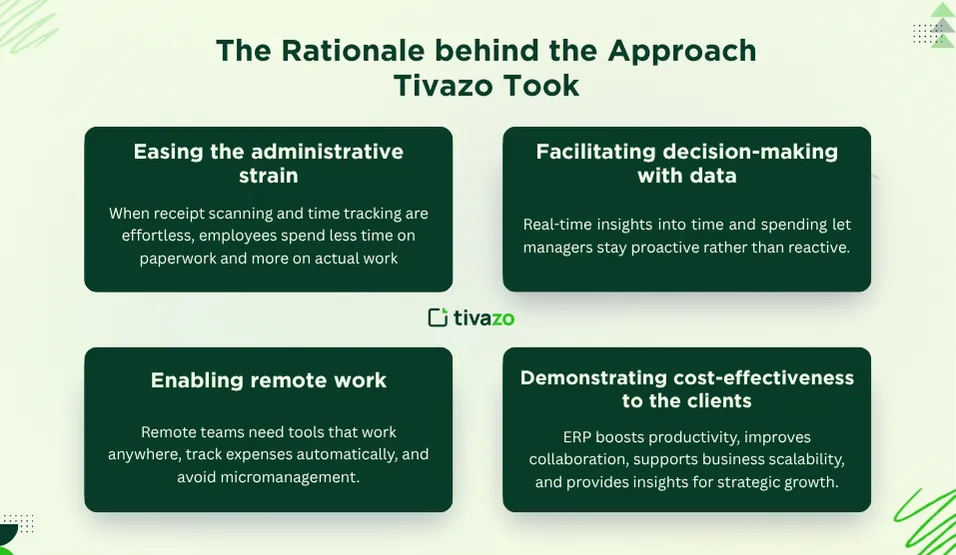
- Easing the administrative strain: When receipt scanning and time logging are at ease of collaboration, employees participate less in paperwork and instead do more of the actual work.
- Facilitating decision-making with data: Real-time monitoring of where time and money are spent enables managers to be proactive and not reactive.
- Enabling remote work: Remote work teams require a tool that is usable anywhere, that automatically checks on spending, and that does not require micromanagement.
- Demonstrating cost-effectiveness to the clients: Detailed time logs with expense receipts will provide undeniable billing records and prove your rates.
- Contracting the total project costs: All the hours spent, all the costs, all resources, all in a single place
The platforms that will most likely work will be those that render time and expense tracking so smooth that employees will actually adhere to them, as informative as managers will be unable to do without the data, and so connected that finance teams will stop drowning in paperwork.
The Bottom Line
The technology of receiving scans has developed into an advanced business infrastructure since it started as a novelty, cashback to consumers. This OCR and AI that assists shoppers to save pennies back is the same that assists businesses to win thousands of dollars of billable time and uncompensated costs.
The intelligent companies understand that time tracking and expense management cannot be considered different issues, as they are the two sides of the same coin. An hour of time not accompanied by the expenses involved is incomplete. A receipt that is made without context as regards the project-supported causes accounting pains.
The platforms that cohesively combine such functions, such as Tivazo, are addressing real issues to real companies. They are transforming fragmented information (timesheets, receipts, project notes, mileage logs) into operational intelligence to enhance profitability, productivity, and decision-making.
These integrated platforms are not a nice-to-have tool as work is getting more remote, project-based, and distributed. The only issue is how swiftly businesses will embrace them ahead of their competitors.
Willing to eliminate money wastage due to inadequate time and cost tracking? Tivazo is a modern workforce management platform that uses the power of technology in receipt scanning along with full time tracking that can provide you with full visibility on where every hour and every dollar is going. Since in business you can improve nothing that you cannot measure.


